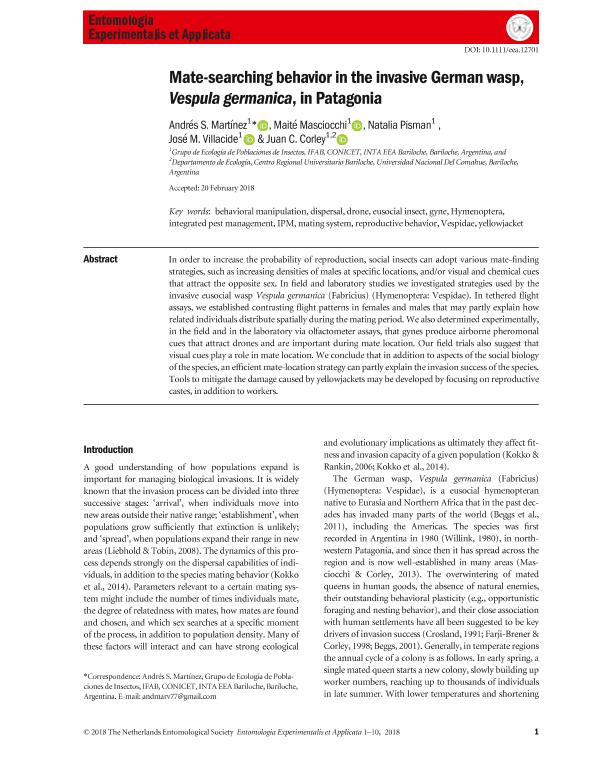Artículo
Mate-searching behavior in the invasive German wasp, Vespula germanica, in Patagonia
Martínez Burkett, Andrés Santiago; Masciocchi, Maité ; Pisman, Natalia; Villacide, José M.; Corley, Juan Carlos
; Pisman, Natalia; Villacide, José M.; Corley, Juan Carlos
 ; Pisman, Natalia; Villacide, José M.; Corley, Juan Carlos
; Pisman, Natalia; Villacide, José M.; Corley, Juan Carlos
Fecha de publicación:
07/2018
Editorial:
Wiley Blackwell Publishing, Inc
Revista:
Entomologia Experimentalis et Applicata
ISSN:
0013-8703
Idioma:
Inglés
Tipo de recurso:
Artículo publicado
Clasificación temática:
Resumen
In order to increase the probability of reproduction, social insects can adopt various mate-finding strategies, such as increasing densities of males at specific locations, and/or visual and chemical cues that attract the opposite sex. In field and laboratory studies we investigated strategies used by the invasive eusocial wasp Vespula germanica (Fabricius) (Hymenoptera: Vespidae). In tethered flight assays, we established contrasting flight patterns in females and males that may partly explain how related individuals distribute spatially during the mating period. We also determined experimentally, in the field and in the laboratory via olfactometer assays, that gynes produce airborne pheromonal cues that attract drones and are important during mate location. Our field trials also suggest that visual cues play a role in mate location. We conclude that in addition to aspects of the social biology of the species, an efficient mate-location strategy can partly explain the invasion success of the species. Tools to mitigate the damage caused by yellowjackets may be developed by focusing on reproductive castes, in addition to workers.
Archivos asociados
Licencia
Identificadores
Colecciones
Articulos(CCT - PATAGONIA NORTE)
Articulos de CTRO.CIENTIFICO TECNOL.CONICET - PATAGONIA NORTE
Articulos de CTRO.CIENTIFICO TECNOL.CONICET - PATAGONIA NORTE
Citación
Martínez Burkett, Andrés Santiago; Masciocchi, Maité; Pisman, Natalia; Villacide, José M.; Corley, Juan Carlos; Mate-searching behavior in the invasive German wasp, Vespula germanica, in Patagonia; Wiley Blackwell Publishing, Inc; Entomologia Experimentalis et Applicata; 166; 7; 7-2018; 555-564
Compartir
Altmétricas



